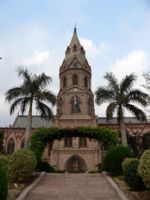Difference between revisions of "Lahore"
(→Places of interest) |
(→Maps: 1893) |
||
| Line 111: | Line 111: | ||
==Maps== | ==Maps== | ||
| − | [http://www.lib.utexas.edu/maps/historical/lahore_1912.jpg Lahore Map 1912] from the Historical Maps of Asia Collection, University of Texas, Austin | + | * [http://en.wikipedia.org/wiki/File:1893_Map_of_Lahore.jpg Lahore Map 1893] from Wikipedia Commons |
| − | + | * [http://www.lib.utexas.edu/maps/historical/lahore_1912.jpg Lahore Map 1912] from the Historical Maps of Asia Collection, University of Texas, Austin | |
==References== | ==References== | ||
Revision as of 09:46, 3 October 2010
| Lahore | |
|---|---|
| [[Image:|250px| ]] | |
| Presidency: Bengal | |
| Coordinates: | 31.545073°N 74.340835°E |
| Altitude: | 217 m (712 ft) |
| Present Day Details | |
| Place Name: | Lahore |
| State/Province: | Punjab |
| Country: | Pakistan |
| Transport links | |
Lahore was the capital of undivided Punjab until Partition in 1947, after which it became the capital of West Punjab in Pakistan.
Contents
History
Churches
Anglican
- Lahore Cathedral (Cathedral Church of Resurrection) - consecrated in 1887
- St Andrew's (The Railway Church) - built in 1899 to serve the Railway colony, near the North Western Railway Headquarters
- St Anthony's - also near the North Western Railway Headquarters on Empress Road
Roman Catholic
- Cathedral of the Immaculate Conception - built 1861
- Sacred Heart Cathedral - consecrated 1907, the seat of the Diocese of Lahore
Education
Schools
- Convent of Jesus and Mary
- Queen Mary College
Colleges/University
- Government College (now University) (1864)
- Islamia College
- King Edward Medical College (now University)
- University of Punjab
Health
Hospitals
- Lady Aitchison Hospital
- Mayo Hospital (1871)
- Sir Ganga Ram Hospital (1921)
Dispensaries
Cemeteries
Commercial
Banks
- The Australasia Bank (1942)
- Punjab National Bank (1895)
Military
The Cantonment was situated 3 miles east of the civil station of Lahore and until 1906 was known as Mian Mir (alternative spelling Mean Meer, Meean Meer)
Lahore was the head-quarters of the Punjab Light Horse and of the 1st Punjab Volunteer Rifles.[1] "A Beleagured City",is a parody by Rudyard Kipling about the proximity of the firing range of the Punjab Volunteer Rifles to the Lawrence Hall Gardens
Transport
Railways
- Lahore Railway Station
Lahore was the headquarters of North Western Railway. There were railway workshops and a railway colony.
Places of interest
- Walled City of Lahore
- Maryam Zamani (Begum shahi) Mosque (near Fort)
- Lahore Museum. The Mall
- Nawab Bahadur Khan's tomb. (used as a theater hall during the early period)
- Mahabat Khan's tomb and Boundary Wall, Baghbanpura (near Shalimar Gardens)
- Prince Perwaiz's tomb. Chah Miran area.
- Wazir Khan's Hammam
- Wazir Khan's Baradari (served as soldier's quarters until cantonment shifted to Mian Mir.) Behind Lahore Museum.
Protected Monuments
The following are historical monuments protected during this era. The year is brackets is the year of their notification.
- Akbari Sarai and Mosque (1911)
- Anarkali's Tomb (1924) (serves at the Punjab Records Office since 1891) in Punjab Civil Secretariat.
- Asif Khan's tomb and compound (1911)
- Buddhu's Tomb (1912) near Gulabi Bagh Gateway on Grand Trunk Road
- Chauburji (1913). Mozang
- Dai Anga's Mosque, Naulakha. (1913) (private residence of Mr. Henry Cone, editor of Lahore Chronical. later sold to the Railways. restored as mosque in 1903)
- Dai Anga's Tomb (1913). behind Gulbai Bagh Gateway
- Gulabi ?Bagh Gateway (1913)
- Jahangir's Tomb (1911)
- Lahore Fort (1920, 1924)
- Mirza Kamran's Baradari (1935)
- Tomb of Musa Ahangar, Mosque and House (1914). near Railway Station.
- Nur Jahan's tomb (1911)
- Qutbuddin Aibak's Tomb (1914)
- Roshnai Gate (1935) (part of the fortification wall)
- Shalimar Gardens (1913)
- Wazir Khan's Mosque (1925)
Statues
The following are some of the people whose statues were erected during the period. All except one has been removed from their original locations.
- Queen Victoria
- King Edward VII
- Lala Lajpat Rai
- Professor Alfred C. Woolner
- Sir Ganga Ram
- Sir John Lawrence
Maps
- Lahore Map 1893 from Wikipedia Commons
- Lahore Map 1912 from the Historical Maps of Asia Collection, University of Texas, Austin
References
External links
"'A Feeling of Absence from Old England:' the Colonial Bungalow" by William J Glover. Home Cultures Volume 1 Issue 1 pages 61-82 2004(?). Contains references to Lahore from page 3 of the pdf. “By the late nineteenth century, Lahore was a desirable posting for European officers and civilians due to its large size, moderate climate, and relatively cosmopolitan range of institutions and activities.”
Historical books online
- "Lahore City", pages 37-40 and "Lahore Cantonment", page 40 from Imperial Gazetteer of India : Provincial Series Punjab Volume II The Lahore, Rawalpindi and Multan Divisions and Native States, 1908 Archive.org
- Punjab disturbances, April 1919; compiled from the Civil and military gazette 1919 Archive.org
- "Lahore Central Jail", page 95 from Professional papers on Indian engineering, Volume 5 1868 Google Books

